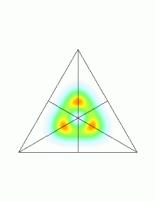Structure and stability of multiply excited states of atoms
Studying structure and dynamics of multiply excited states of atom and molecules provide useful information for various applied fields such as plasma physics, radiation physics, astrophysics, etc. When more than two electrons are simultaneously excited, they are not adequately described by the traditional independent particle model. The electrons tend to move jointly, and execute stretching and bending vibrational motions about the equilibrium positions and overall rotational motions.

Triply excited states of atoms
Since the experimental observation of doubly excited states of He in 1960fs, large effort has been devoted to study electron correlations in the doubly excited states, both theoretically and experimentally. In last few years, efforts have been made toward the understanding of three-electron systems. We have made major contributions in this field, from doubly excited states to triply excited states of a three-electron atom. To facilitate the understanding it is imperative to have a way to visualize the different quantum mechanical modes of the collective motion of the electrons.@(See fig below) This is not easy since the configuration space is multi-dimensional. We calculated the accurate wavefunctions in hyperspherical coordinates with full inclusion of electron correlation. We developed tools for partial projection such that the nature of the normal modes of their motion can be visualized in two or three dimensions. We were able to show that electron correlation in triply excited states is isomorphic to the stretching and rotational and vibrational modes of a floppy XY3 molecule. This allows us to succeed in providing a new classification scheme for triply excited states of atoms, which plays the same important role as the Hatree-Fock model for singly excited states in atoms and molecules. We also identified the positions and the Auger widths of triply excited states produced by triple capture in ion-atom collisions in collaboration with Prof. T. J. M. Zourosfs experimental group in Greece.
 A density plot of a triply excited state in collective coordinates. See more.
A density plot of a triply excited state in collective coordinates. See more.
\_¶
gHyperspherical Hierarchy of Three-Electron Radial Excitationsh,
T. Morishita, O.I. Tolstikhin, S. Watanabe, and M. Matsuzawa,
Phys. Rev. A 56, 3559-3568 (1997)
gHyperspherical Analysis of Doubly and Triply Excited States of Lih,
T. Morishita and C. D. Lin,
Phys. Rev. A 57, 4268-4274 (1998)
gAnalysis of 1s2l2l' and 2l2l'2l'' resonances of He|ionsh,
T. Morishita and C. D. Lin
J. Phys. B: At. Mol. Opt. Phys. 31, L209-L217 (1998)
gVisualization of correlations in intrashell triply excited states of atomsh,
T. Morishita, Y. Li
gComprehensive
analysis of electron correlations in three-electron atomsh,
T. Morishita and C.D. Lin
Phys. Rev. A 59, 1835-1843 (1999)
gIdentification and visualization of the collective normal modes of
intrashell triply excited states of atomsh,
T. Morishita and C. D. Lin,
J. Phys. B: Atm. Mol. and Opt. Phys. 34, L105-L111 (2001)
gClassification and rovibrational normal modes of 3l3l'3l'' triply excited
states of atomsh',
T. Morishita and C. D. Lin,
Phys. Rev. A 64, 052502 (19 pages)(2001)
gRadial and angular correlations and the classification of intershell 2l2l'3l''
triply excited states of atomsh,
T. Morishita and C. D. Lin,
Phys. Rev. A 67, 022511 (13 pages)(2003)
gExperimental
observation and theoretical calculations of triply excited 2s2p2 2Se,
2,4Pe, 2De and 2p3 2Po,
2Do states of fluorineh,
M. Zamkov, E. P. Benis, C. D. Lin, T. G. Lee, T. Morishita, P.
Richard, and T. J. M. Zouros
Phys. Rev. A 67, 050703(R) (4 pages)(2003)

Stability of excotic quantum systems
Another interesting subject in three electron systems is doubly charged negative ion, H2|. Singly charged hydrogen negative ions, H|, are known to exist and have been widely studied. Since 1970fs, many mathematicians, physicists, and chemists have been fascinated with the possibility of finding bound or resonant states of H2| both experimentally and theoretically. I have shown that no resonance or bound state can exist for the nuclear charge of Z less than about 1.6 from Hyperspherical adiabatic potentials. We also discussed the quantum stability of the so called gexotic atomsh such as alkali atoms with a positron (e+).
References
gNonexistence of resonances in H2|h,
T. Morishita, C.D. Lin, and C.G. Bao
Phys. Rev. Lett. 80, pp. 464-467 (1998)
gStable bound states of e++ Li and e++ Nah,
J. Yuan, B. D. Esry, T. Morishita, and C. D. Lin
Phys. Rev. A 58, R4-R7 (1998).

Four electron correlations
In addition, we extended our analysis to 4-electron atomic systems, where one can expect much richer electron correlation effects. There are intriguing questions to address: Since a 4-electron system can have two possible equilibrium positions - a planar or a pyramidal configuration. Which geometry is more stable quantum mechanically? Searching for quadruply excited states using Synchrotron radiation is only in the very early stage. We formulated the system in hyperspherical coordinates and discussed the radial correlation effects based on the quantum symmetry.



 Four electron radial wave functions in hyperepherical coordnnates.
Four electron radial wave functions in hyperepherical coordnnates.
References
gHyperspherical analysis of radial correlations in four-electron atomsh
T. Morishita and C. D. Lin,
Phys. Rev. A 71, 012504 (2005) (9 pages)


 A density plot of a triply excited state in collective coordinates. See more.
A density plot of a triply excited state in collective coordinates. See more.





 Four electron radial wave functions in hyperepherical coordnnates.
Four electron radial wave functions in hyperepherical coordnnates.
